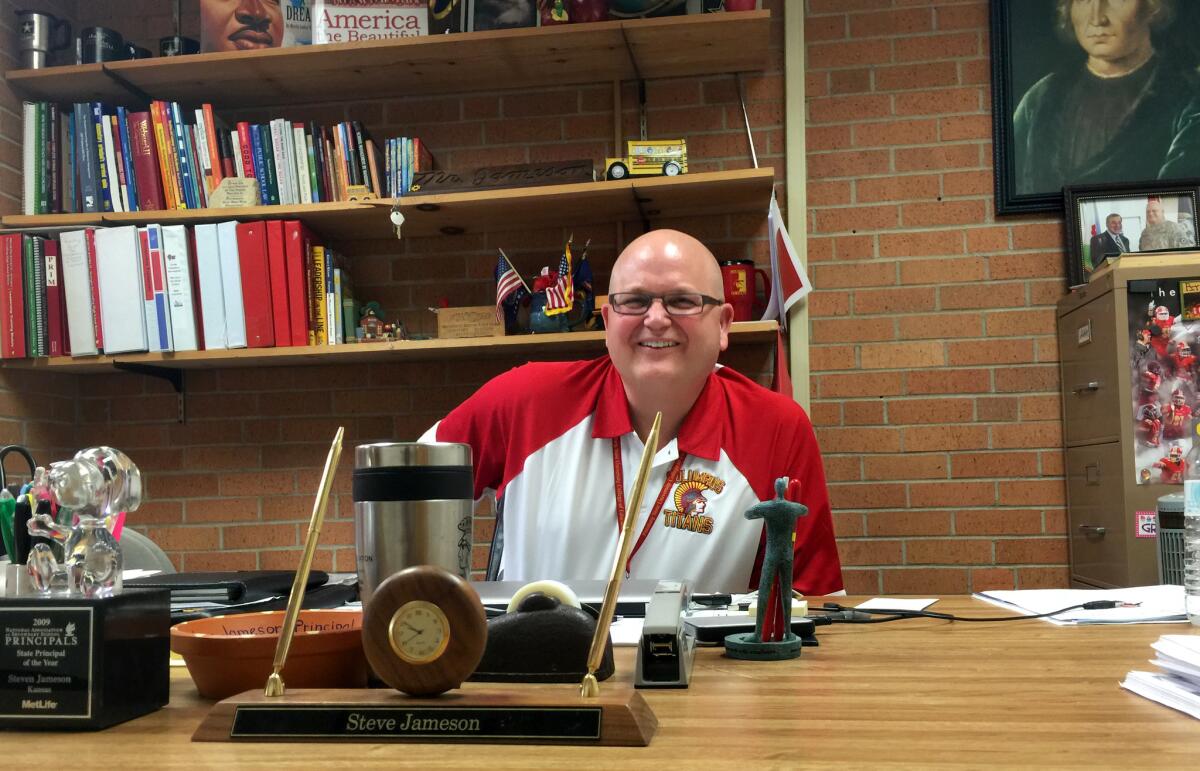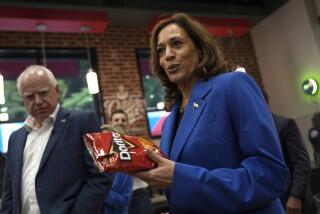Hard times for Kansas and its schools as economic ‘experiment’ creates gaping budget hole
- Share via
Reporting from COLUMBUS, Kan. — In February 2015, three years into the supply-side economics experiment that would upend a once steady Midwestern economy, a hole appeared in Kansas’ finances.
To fill it, Gov. Sam Brownback took $45 million in public education funding. By April of this year, with the hole at $290 million, Brownback took highway money to plug it. A month later, state money for Medicaid coverage went into the hole, but the gap continued to grow.
Today, the state’s budget hole is $345 million and threatens the foundation of this state, which was supposed to be the setting for a grand economic expansion but now more closely resembles a battleground, with accusations and lawsuits flying over how to get the state’s finances in order.
The yawning deficits were caused by huge tax cuts, championed by Brownback and the Republican-dominated Legislature, that were supposed set the economy roaring. They didn’t.
The budget shortfalls have been felt across the state, particularly by public schools, and have embroiled the Kansas Supreme Court along with state lawmakers and the governor.
Through it all, Brownback has repeatedly pledged his faith in the free market.
“We’re going to continue to grow the economy,” Brownback has said in response to questions about each new revenue shortfall.
His opponents in the Legislature say Brownback’s mantra has failed the state and carries a stern lesson in theory versus reality to other states contemplating the same free-market ideas.
“It’s estimate and pray on the income taxes,” said state Sen. Laura Kelly, ranking Democrat on the Ways and Means Committee. “Even with significant changes, we won’t see personal income receipts [increase] until 2019.”
An ideological war over the way Kansas collects and spends money has erupted in the capital of Topeka and spilled into every corner of the state. After five years of an economic crusade that has left its originator, Brownback, as the least popular governor in the nation, Kansas has been forced to use the settlement from a national tobacco lawsuit to cover the hole in its general fund budget — money that was supposed to go to an early childhood education endowment.
It was a risk Brownback ran when he overhauled the state budget based on an interpretation of fiscal conservatism that dramatically cut personal income taxes.
The state would thrive, he pledged, because the tax cuts would help keep businesses and smart, young Kansans in the state, not fleeing “to Houston, or Dallas, or Chicago or somewhere else.”
“It will pave the way to the creation of tens of thousands of new jobs, bring tens of thousands of people to Kansas, and help make our state the best place in America to start and grow a small business,” Brownback wrote in 2012. “It will leave more than a billion dollars in the hands of Kansans. An expanding economy and growing population will directly benefit our schools and local governments.”
It hasn’t worked out that way.
Revenue from income tax collections plummeted 22%. A separate repeal of taxes on partnerships and limited liability companies meant the surrender of 30% of state revenue.
It’s been disastrous.
— Burdett Loomis, political science professor, on Kansas’ tax cuts
A projection issued Nov. 11 puts Kansas in a bind next fiscal year, when state revenue estimators project receipts to amount to $5.5 billion, down 7.4% from this year’s estimate.
Unwilling to scale back the income tax cuts, the state did increase the sales tax. Now Kansas has the second-highest sales tax in the nation, and such reliance on sales taxes has saddled the state with additional problems: Deflation is dropping the prices of goods and the taxes the state collects on them.
Tired of the bleating horn of bad news, in September Brownback silenced a quarterly economic evaluation of the state that counted employment, unemployment, personal income and energy production, and consistently illustrated the state’s plunging revenues. He had done so before, in August 2015, when he ordered a halt to a semiannual economic report.
“A lot of people were confused” by the reports, said Nicole Randall, a spokeswoman for the Kansas Department of Commerce.
Brownback’s ultraconservative allies in the Legislature paid the price for their loyalty in the August primaries — when moderate Republicans won while running against Brownback and for increases in school funding — and again on election day, when Democrats picked up 12 seats in the House.
“It’s been disastrous,” said Burdett Loomis, professor of political science at the University of Kansas. “Brownback has said he will work with [new, moderate] legislators, but I don’t know if anyone believes him.”
The budget battles have also brought in the state Supreme Court. In 2014 the court ruled that disparities in public funding of education violated the state constitution and ordered a lower court to evaluate how much the state should invest in public schools.
Conservative groups supporting Brownback responded by pushing five Supreme Court justices into brutal, expensive retention races to keep their seats. The targeted justices were retained by voters and are expected to rule this month on the adequacy and fairness of the public education system in a landmark case, Gannon vs. Kansas, filed by four of the state’s poorest school districts.
Should the Supreme Court rule against the state and the adequacy of its $6-billion yearly expenditures on education, it will force Kansas to pay $500 million or more for school upgrades across the state, including in economically depressed areas.
Places like Columbus.
Here in the state’s southeast corner, the poorest area in Kansas, coal mines died and gave way to paper mills, which shuttered as American business went paperless. Today, nearly 30% of families with children in the region receive food stamps. In Pittsburg, the largest city in the area, with about 20,000 residents, the downtown is pocked by shuttered storefronts.

In Columbus, population 3,300, clean, manicured lawns front one-story ranch houses built when the area was still prosperous, or at least on its feet. Red-and-yellow flags of Pittsburg State University, located in the nearby town, dot the one-street downtown. Greenery abounds.
“We’re a little bit — what’s the word I want to use — I’m a little bit backwoods. We’re a little rough around the edges,” said Steve Jameson in his seat in the principal’s office at Columbus’ Park Elementary. “We’re hard workers, and it’s high poverty. Sometimes, in poverty, you have that sense of helplessness.”
Jameson believes wholeheartedly in the importance of pre-K education, especially for the summer before kindergarten. His pre-K funding is frozen at 2013 levels because of the cuts, meaning he can enroll 30 children in summer pre-K. He has a waiting list every year.
He has been told that next year summer’s pre-K program will be cut. Jameson knows what to expect next fall.
It means kindergarteners from at-risk backgrounds never before introduced to a school environment, or children with behavioral issues that have not yet been modified in a classroom setting — all of those issues and inexperience exploding in a class of 12 to 15 other children.
But such a disruption is just the beginning, experts say, because it slows down the rest of the class, which drags down their development entering school.
Jameson has tried to keep the cuts away from the classroom. He let one teacher’s assistant go, and has been unable to send his teachers to professional development conferences — admittedly smaller cuts, but ones he said would compound over time.
“In the long run, teachers won’t have that energy if you don’t provide professional development, and they’ll go elsewhere,” Jameson said.
Public education in Kansas is coming apart at the seams, and Jameson can no longer recommend to others what is his family’s vocation.
So it was with a wavering voice that he told one of his favorite onetime high school students, now a college graduate, that she should seek work as a teacher 12 miles east, in rival Missouri, because cutbacks to the education system in Kansas leave him unable to promise the future of his investment to her.
“It was hard. I wanted her to make the best choice for her,” Jameson said. “I was always proud of Kansas education. I can’t be as strong about that conviction anymore.
“The finances are making it hard to meet the needs of our kids,” he said. “The climate makes it hard to recruit good teachers. If you hear the legislators bashing you all the time, the governor bashing you all the time, you can choose to go to another state.”
Changes to the Legislature could reverse course, but the process will not be easy, Loomis said. Even with repeals of the tax exemptions of LLCs and partnerships, which could amount to several hundred million dollars, the changes will be “a drop in the bucket.”
Other than sunny repetitions of Brownback’s mantra that the economy will indeed reverse course once his economic experiment has a chance to work, there are no short-term plans to save the state.
Even if the Legislature raises personal income taxes and repeals the exemption on business taxes, the state will not see its first receipts until 2018.
In the meantime, the hole grows and grows.
“It demonstrates the pickle that Brownback and the Legislature have gotten this state in,” Loomis said. “There’s no easy way out.”
Twitter: @nigelduara
MORE NATIONAL NEWS
Democrats ask themselves: Now what? Who’ll lead the party from the wilderness, and how?
Obama administration bans Arctic offshore oil drilling through 2022. But will Trump reverse it?
There’s a reason few even knew the Dakota Access pipeline was being built
More to Read
Sign up for Essential California
The most important California stories and recommendations in your inbox every morning.
You may occasionally receive promotional content from the Los Angeles Times.











